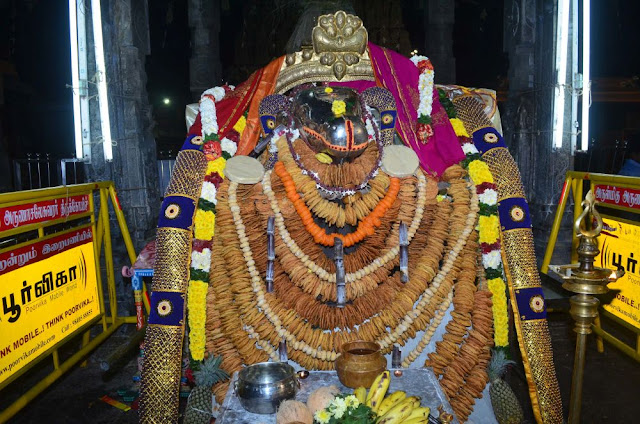In an earlier posting I wrote that the Gods go on procession several times around the perimeter streets of Arunachaleswarar Temple (mada veedhis) on the 3rd day of the Pongal Festival.
After the Gods have completed their processional circumambulation, they retire to the Alankaram Mandapam (outside the Raja Gopuram) and wait for the evening. In the evening the Gods set out towards Thiruvoodal Street to enact their “divine quarrel”.
The word 'Thiru' signifies; deity, sacred, holy and wealth and the word 'Voodal' actually means 'tiff' or 'petty quarrel', and represents the friction between the male and female in a love relationship which is consciously exacerbated. The distinguishing mark of Voodal is that it should arise and stay only for a brief period and not be prolonged as its focus is the bliss when the Voodal is withdrawn.
The actual staging of the Divine Quarrel is re-enacted on the madaveedhi street named Thiruvoodal Street in celebration of this Divine Drama.
 |
| Gods on Thiruvoodal Street having their "tiff" (photo from previous year) |
After their quarrel, the Goddess continues her procession on the mada veedhi streets, circumambulates the Temple and re-enters via the Thitti Vassal Gate. Lord Shiva however turns left off Thiruvoodal Street and moves onto Thirumanjana Street until he reaches Kumara Koil (Temple famous for daily supplying consecrated water to the Big Temple). At that place He spends the night.
The next morning He performs girivalam and gives His blessings to devotees during His circumambulation of the Hill.
Maruvoodal
When Lord Shiva completes his girivalam he returns to Arunachaleswarar Temple and wishes to have a reunion with his consort. This part of the Festival is known as Maruvoodal. The point of the Maruvoodal myth is to show that even a Celestial Couple has differences between them. But in the end there should only be reunion.
Returning to his residence, Shiva knocks but it has been bolted by Parvati. Lord Shiva asks,
‘Oh my darling why have you locked the door?’
‘Sir after we came to an understanding still you went without me. And see now look you have lost everything there is no ornament or clothes. Not, only that but you went and gave darshan to all kinds of people. So, I am now requesting you must establish your manliness to me and retrieve everything that is lost and give the special one-legged dance.’
Shiva starts the dance, Parvati forgets everything and opens the door.
Their reunion is complete.


















































